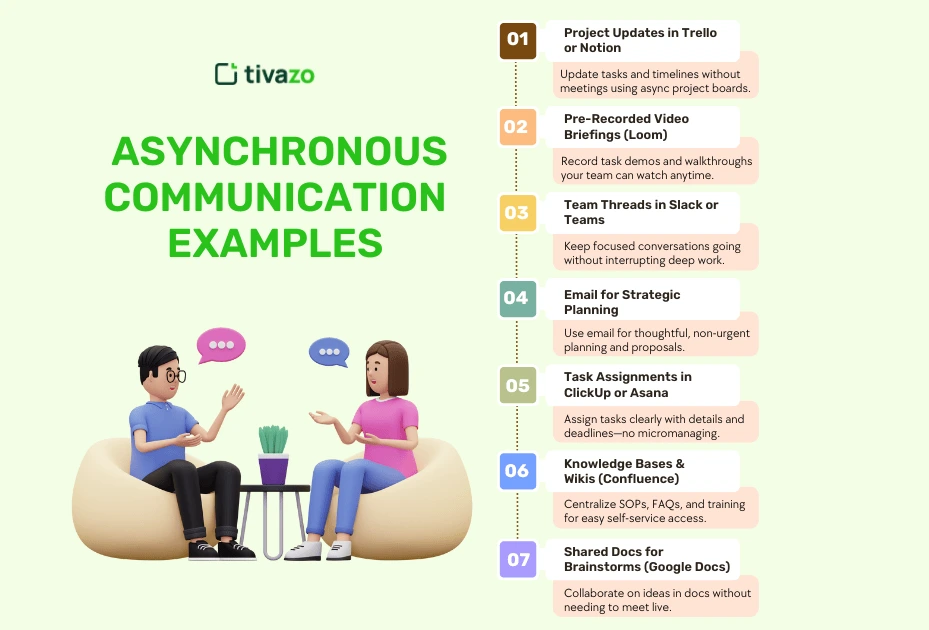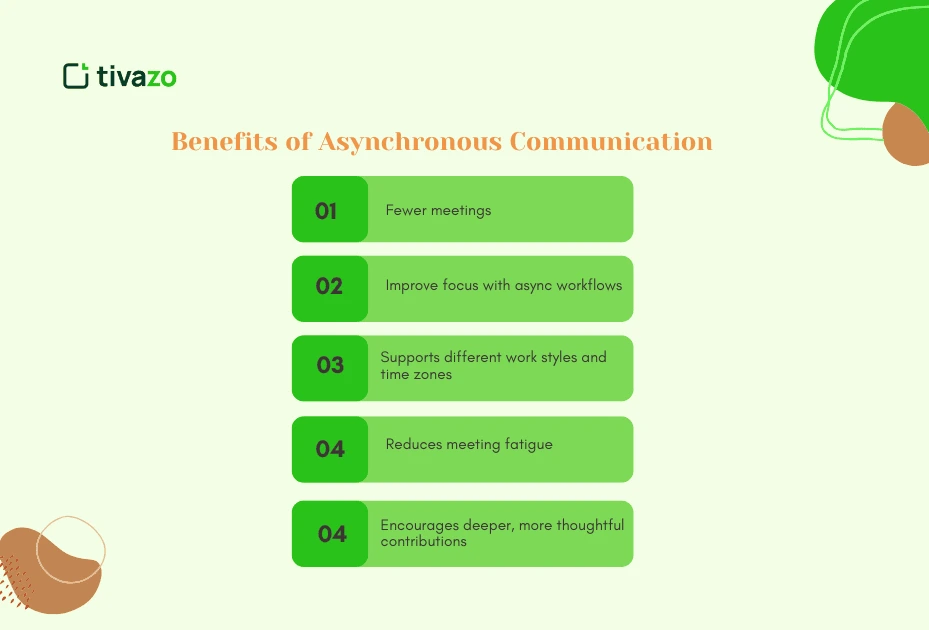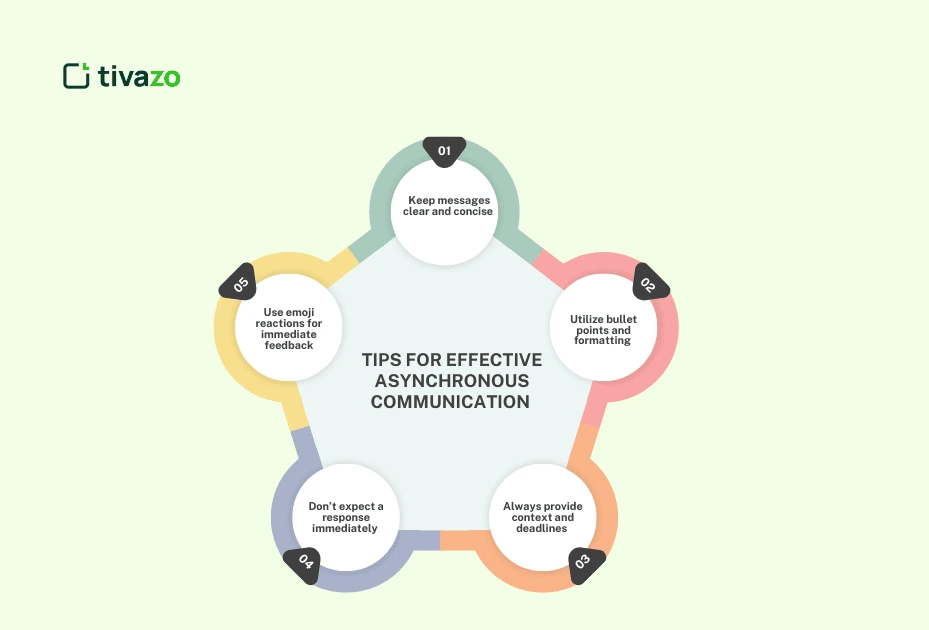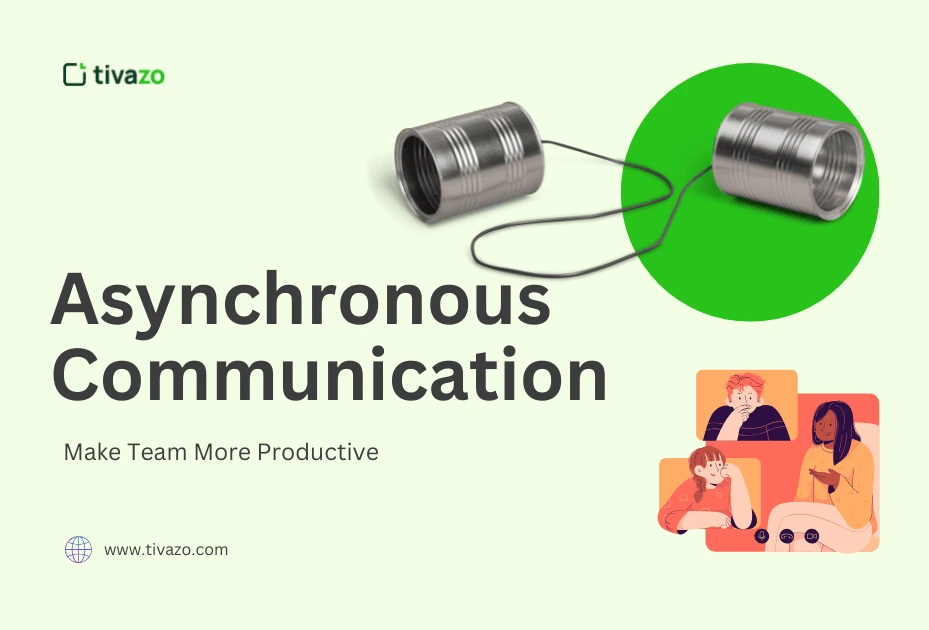Tired of cycling through meeting after meeting, slow responses, and losing focus at work? You’re not alone. In an increasingly either hybrid or remote-first world, real productivity in 2022 is to work smarter, not louder. That’s the power of asynchronous communication.
Instead of chasing after real-time responses, teams that integrate asynchronous communication ultimately save time, create clarity, and achieve long stretches of deep work. This guide will walk you through some practical, beginner-friendly ways to apply the benefits of async tools, whether you’re new to async or managing a distributed team that works across multiple time zones.
Let’s dive into how we can design workflows that improve team productivity without the stress of back-to-back meetings.
Key Highlights:
- What is Asynchronous Communication in the Workplace
- 7 Asynchronous Communication Examples That Make Teams More Productive
- Benefits of Asynchronous Communication
- Asynchronous vs Synchronous Communication: Key Differences
- Tips for Effective Asynchronous Communication
- How to Train a Team for Asynchronous Communication
What is Asynchronous Communication in the Workplace?
Asynchronous communication is those in which a response is not expected or required immediately. Instead of hopping on a live call, you leave a message, document, or comment for someone to come back to at their convenience.
Examples include:
- Posting updates in Slack threads
- Creating a Loom video where you share an update
- Adding comments in Google Docs
- Trello cards with details
Asynchronous communication is separate from synchronous communication (real-time), like Zoom meetings or phone calls.
Why Asynchronous Communication Examples Matter More Than Ever
Distributed teams are often spread across time zones and have different schedules. Communicating in real-time can result in constant interruptions and can be detrimental to productivity. Using asynchronous communication options allows members to respond when it works for them, arranging work around their natural energy and availability.
Asynchronous communication provides flexibility to lower stress levels, maintain mental energy, and create space for sustained, uninterrupted productivity. Choosing asynchronous communication tools means reduced meetings and better management of time
- Improved time management
- Fewer unnecessary meetings
- Less burnout
- Greater autonomy
The result? More output with fewer interruptions.
7 Asynchronous Communication Examples That Make Teams More Productive
Here are examples of asynchronous communication from the real world to facilitate collaboration for teams, especially in remote or hybrid environments:

1. Project Updates in Trello or Notion
Instead of scheduling regular team-wide status calls that can interfere with individuals’ workflows, teams can leverage project management platforms like Trello or Notion to share updates in a purely asynchronous manner. Each (or a member of the) team will log their work completed, add comments or information, and update progress on tasks in shared Trello boards or within Notion pages.
The best part is that there is clear visibility into the project timelines, what each individual is responsible for, and what has been accomplished, so that none of the team has to be available at the same time. Everyone in the team will have an organized, searchable source of communication; therefore, they will not have to ask
2. Pre-Recorded Video Briefings (e.g., Loom)
Written communication can’t always adequately describe something complex or the instructions for a complex project. Pre-recorded video tools, such as Loom, allow you to capture your screen and voice together to provide a detailed walkthrough, presentation, or demo.
Team members are able to watch these videos whenever they have time, and they can go back and review them if they wish. This removes ambiguity and saves time with unnecessary follow-up messages clarifying instructions in multiple messages or in a live call. Video briefings also provide a personal touch that facilitates communication, clarity, and engagement.
3. Team Threads in Slack or Microsoft Teams
As we mentioned, Slack and Microsoft Teams offer threaded discussions, and these are great for a more asynchronous communication style. Threads allow you to have more in-depth communications without flooding the main channel with random messages. When things are threaded, everything is in one place.
Team members can chime in, and if the threads go off the rails, responses to specific things are done when it’s convenient. Since asynchronous communication allows team members to focus on their work, incorporating threads supports the same productivity by minimizing disruptions. For example, you can use threads for your daily standup meeting, while requesting feedback, or just brainstorming. This also allows you to manage communication across many time zones with no time restrictions at all.
4. Email for Strategic Planning
For deep conversations such as strategic planning, proposals, and documentation review, email is an important asynchronous tool. When someone is sent an email, they have the opportunity to read, consider, and respond to it at their own pace, as opposed to instant messaging, where recipients have to respond right away.
Email, when written well, is a formalized record of discussion and decision-making, which becomes an important record of accountability and referral for the team. Using emails for these conversations allows teams to require less formal meeting time and helps all team members contribute in a mindful and significant way that is unpressured.
5. Task Assignments in Project Tools
Clear task management is essential for productivity for individuals and teams. However, systems like ClickUp, Asana, or Motion enable managers and teammates to assign tasks with ample detail, deadlines, and priority.
Providing team members with their tasks assigned in a collaborative manner stops any confusion or overlapping of work to be done. When tasks are clearly outlined, each person can plan their day effectively, know what to accomplish, and track their progress. An asynchronous and organized approach to task management allows team members to become part of the action and not just a check-in or micromanagement to oversee.
6. Knowledge Bases & Wikis (e.g., Confluence)
A knowledge base or wiki (like a Confluence site) can hold all the key information in one place, including SOPs, FAQs, and onboarding materials. If this information is kept up to date in a single, searchable, and readily accessible repository, then individuals can spend less time answering repetitive questions and more time doing productive work.
Instead of burdening a supervisor or colleague with questions, anyone in the group can independently find answers to their day-to-day inquiries. The team can practice independence while keeping workflows running smoothly when they can work through their questions.
7. Shared Docs for Collaborative Brainstorms
Tools such as Google Docs can be great for teams as they allow collaborative brainstorming and creative projects to be created asynchronously. Team members can share ideas, make comments, or suggest edits in real-time together or whenever they are available. Comment threads, suggesting mode, and the ability to highlight an individual contributor with a different color assist in identifying who contributed ideas or commentary.
Keeping the participants physically apart for input encourages thoughtfulness from everyone regardless of location and schedule while creating a stronger idea through iterative collaboration without the need for synchronous meetings.
Benefits of Asynchronous Communication
Moving out of real-time conversations into the asynchronous communication space provides many meaningful benefits that enhance the way teams collaborate. By allowing people to respond in their busy schedules, asynchronous communication allows people to respect their work rhythms while freeing themselves from the chaos of interruption.
This provides an opportunity to slow down, focus more acutely, make more effective decisions, and collaboratively reflect on the future of the work at hand.
Let’s look at some of the most important positive aspects that asynchronous communication offers as a foundational strategy for modern teams:

- Fewer meetings
- Improve focus with async workflows
- Supports different work styles and time zones
- Reduces meeting fatigue
- Encourages deeper, more thoughtful contributions
Asynchronous vs Synchronous Communication: Key Differences
| Feature | Synchronous | Asynchronous |
|---|---|---|
| Timing | Real-time | Delayed responses |
| Tools | Zoom, Calls, Live Chat | Slack, Email, Loom, Docs |
| Best for | Urgent, emotional talks | Detailed updates, planning |
| Productivity Impact | Interruptive | Focus-friendly |
Asynchronous vs synchronous communication isn’t about picking sides—it’s about choosing the right tool for the task.
How to Implement Asynchronous Communication in Your Team
When trying to establish examples of asynchronous communication in your practice, implement async methods into your tasks that are suitable, like project updates, documentation, or strategy development. Pick the tools that your team is already familiar with, like Slack or Notion, or Loom, to reduce friction and create speed to adoption. You will also need to make sure you set expectations that relate to response times and check-in rhythms to encourage everyone to know when to interact and how. Being mindful to write messages with the complete context upfront will help keep your async communication efficient and clear, and will help avoid long exchanges of messages.
Lastly, try to allocate time for team members to train and onboard themselves on these new habits. Setting up expectations and experiences like this is a way of embedding effective remote team communication strategies that will provide opportunities to engage without the hurdles of availability and time zone considerations.
Top Tools for Asynchronous Communication
- Slack: Threads, scheduled messages
- Loom: Quick screen-recorded updates
- Trello: Visual task management
- Notion: Docs, wikis, project boards
- Pomofocus: Time-block async tasks
- Google Workspace: Docs, Sheets, Slides for async collaboration
- Twist/Basecamp: Built for async-first teams
All are excellent tools to work faster without burnout.
Tips for Effective Asynchronous Communication
When it comes to asynchronous communication examples, you want to communicate smartly and clearly. The biggest challenge, because you will not be getting immediate responses back, is making sure that you communicate in a way that will make it easy for your audience to get everything they need up front.
Clarity gets rid of confusion, which in turn saves time and keeps everyone on the same page. You can enhance the quality and speed of asynchronous collaboration simply by establishing good habits with regard to your writing and interaction.
Here are some practical tips for successfully communicating and building trust in your team:

- Keep messages clear and concise
- Utilize bullet points and formatting
- Always provide context and deadlines
- Don’t expect a response immediately
- Use emoji reactions for immediate feedback
These time-saving work tips help reduce misunderstandings and foster a respectful, productive async culture.
When Not to Use Asynchronous Communication Examples
Asynchronous communication examples can surely be advantageous. But it won’t be right for every instance. When addressing sensitive topics, especially conflict resolution or when emotions are higher, it’s usually better to have a conversation in real time. This will help with avoiding misunderstandings and demonstrate empathy. When you are facing emergencies or urgent situations that require immediate resolution, this also goes for you because asynchronous communication cannot provide immediate information once it is exchanged.
Furthermore, when brainstorming or in other collaborative situations that require immediate back-and-forth discussions or you need quick solutions, you should resort to synchronous communication. Identifying the times in which to pause examples of asynchronous communication, and live connected communication is crucial, because it is not always the right method, and that’s okay.
Async Communication Etiquette Every Team Should Follow
Practice and etiquette are vital with asynchronous communication tools. One of the biggest problems with async messages is when someone repeatedly uses a tag and inundates everyone with notifications. Make sure to use a subject line and title that is clear, informative, and helps the team quickly understand the communication’s purpose.
Make sure your more timely replies, within 24 hours ideally, won’t allow the conversation to slow. When threads or discussions are important during a time period, you should summarize them in threads or documents for awareness and reference.
How to Train a Team for Asynchronous Communication
Successfully adopting examples of async communication takes more than just tools — it takes a cultural shift and repeated practice. Teams need to know what is expected, what the best practices are, and how to change their habits to be successful in an async-first world.
Training will ultimately get everyone on the same page, reduce friction, and ensure everyone is confident in the async workflow and how it is utilized. Building these framework skills will require intentional effort over time, but will yield benefits such as better collaboration, less burnout, and stronger productivity.
- Create an async-first handbook
- Set team-wide norms and response times
- Host async roleplay exercises
- Review progress in monthly retros
- Reward async wins (fewer meetings, more output)
Investing in your team’s development is crucial to workflow optimization and sustainable productivity.
Conclusion + CTA
Asynchronous communication examples are not about dodging interaction. They’re about maximizing it. These asynchronous communication examples demonstrate how real teams recapture their time, mental energy, and momentum.
Try one async habit this week:
- Cancel one meeting
- Replace it with a Loom update
- Share feedback via a doc instead of a call
FAQs
What is an asynchronous example?
Leaving comments in a Google Doc for others to review later is a common asynchronous communication example.
What is an example of synchronous and asynchronous communication?
Synchronous: Zoom call.
Asynchronous: Trello board update or Slack thread.
What is the difference between synchronous and asynchronous?
Synchronous happens in real time (like a live chat); asynchronous allows delayed responses (like email or Loom).
Why do teams prefer asynchronous communication?
It helps reduce meetings, boost focus, and supports teams across time zones without burning out.




